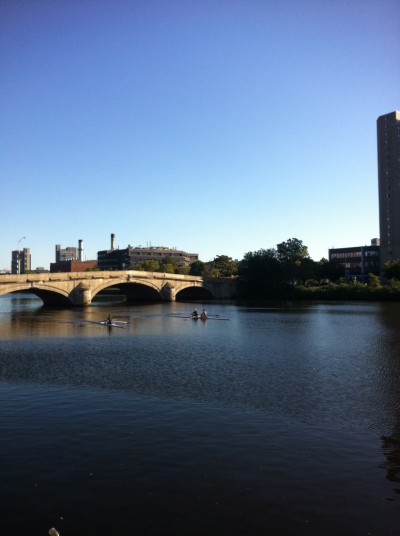I have been teaching yoga to rowers for a number of years. I primarily teach at Community Rowing in Brighton, MA, although I’ve taught the crew team at Northeastern and Boston College as well as the Cambridge Boat Club. Once athletes that row competitively find yoga, they often say it’s their “secret weapon” to build stronger, more anatomically sound rowing strokes, help prevent injury and increase their range of motion. Many of the rowers I’ve worked with have had significant injuries and some have indeed told me that working with physical therapy and yoga together has resulted in measurable increases in ROM (range of motion).
I have a regular student in one of my classes and he’s quite diligent about his practice. After class this week, he asked me a few questions and as it turns out, he’s an Olympic rower. We talked about a few things and I thought I’d share them not only with rowers, but with all practitioners in general as many of them may apply:
Working with tight hip flexors may result in a tilting forward of the pelvis when in lunges. Work to keep the pelvis level. In poses like Warrior 1, Crescent Lunge and basic lunges, a tight hip flexor (Psoas) will result in an anterior tilt of the pelvis. If you think of your pelvis as a bowl, the water will be spilling out the front. As you go deeper in the lunge, keep the pelvis level so the imaginary water stays in the bowl. This will help get the stretch focused on the Psoas (the muscle you’re stretching on the straight leg when you’re in a lunge).
When working Pigeon Pose, which focuses on stretching related muscles (as in the above post: hip flexors), worry less about moving the shin forward towards the front of the mat (on the bent leg) and more about stretching the straight leg and relaxing the shoulders down the back. A great pose for stretching the Psoas is Pigeon. In this pose, the Psoas on the straight leg is stretched. Think of Pigeon’s alignment as you would think of Warrior 1: keep the knee in front of the hip. It’s basically as if you took Warrior 1 pose and knocked it to the ground: same idea, same muscles stretched. Although you could also work the external rotators of the leg that is bent, this takes a great amount of mobility at the hip joint to do this safely, without creating pressure on the medial (inside) aspect of the knee. So, worry less about moving that leg forward and more about stretching the hip flexors. Also, this pose is known for creating a rounded back unless you lift your head to a block and allow the shoulders to relax down the back. If you can do the pose close to the ground (hips, belly, chest) then don’t use the block.
Use a strap for any pose that calls for interlacing the fingers. Rowers have tight shoulders, as evidenced by the typical shape in yoga, “Interlace the hands behind you and fold forward.” When this pose is suggested, the idea is to take the bind and move the arms away from the back. But, if you are tight in the front of the chest and shoulders, this is nearly impossible. You’ll feel like your arms are glued to your back and you can’t move them without crunching into the shoulder joint. So, give yourself more mobility by creating some extra length in the arms. Use a strap instead of lacing the fingers and your arms will move more forward (away from your spine) and you’ll get the stretch your shoulders crave.
Use softness and less muscle as the focus in the poses. Any athlete is used to using muscle to get where he or she needs to go. This often works against you in yoga, especially if you’ve got tight muscles, because the flexibility just isn’t there. As you work with this dynamic you’ll find yourself running into a huge amount of resistance in the body. Perfect example: pushing up into Upward Bow (commonly called Wheel) and you’ve got the requisite strength to “push” but lack the requisite stretch to come up into the pose (especially in the shoulders and hips). So, since the pose is a “push up” but the other way, keep the shoulder joints a little soft and as you push into your feet, keep a little “softness” in your upper body. This will allow you to work with the tightness in your shoulders and search for the pose, while your lower body supports you as you explore it.
Try a restorative yoga class. Related to the above suggestion, take a restorative yoga class in addition to, or in lieu of, a power class. Rowers tend to be drawn to power classes, like all athletes, because it gives them a connection to their strength. But often, the key can be to find that sense of “relaxing into your power” versus pushing all out, all the time. While you might think restorative yoga classes are just a lot of laying around, think again. These classes focus on longer holds, which will get deeper into the connective tissue (tendons and joints). These joint supports need to stretch but through healthy work, not through hyperextending the joints. Also, as these classes are the “yin” to the “yang” of power classes, they’ll help you tap into that softer side that you can call on when competing. Being able to relax while working can help you conserve energy and find that mental edge over your competition.
If you find it hard to work these moves in your body, find a yoga teacher and set up a few privates lessons. It can make a huge difference in your practice.

